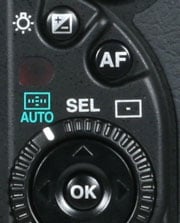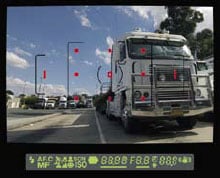Pentax K10D
-
-
Written by Gordon Laing
Pentax K10D lenses
Lenses and viewfinder / Screen and menus / Sensor and processing / Anti shake and anti dust
Pentax K10D features continued…
Lenses and viewfinder / Screen and menus / Sensor and processing / Anti shake and anti dust
The Pentax K10D is equipped with a KAF2 bayonet lens mount which is compatible with KAF2, KAF and KA lenses. Like earlier Pentax DSLRs, the K10D also works with a wide variety of older Pentax optics (albeit with certain restrictions), including K lenses and even S and medium format models with the help of optional adapters; you’ll generally be working in Manual mode with these though.
The K10D is also the first Pentax DSLR to support the new range of DA* lenses equipped with internal supersonic SDM focusing motors; these lenses also sport environmental sealing to match the K10D. To date, two DA* lenses have been confirmed – the 16-50mm f2.8 and 50-135mm f2.8 – with other models including a 60-250mm f4, 55mm f1.4, 200mm f2.8 and 300mm f4 slated for the end of 2007. Look out for forthcoming reviews of Pentax lenses at Cameralabs.
Like all Pentax DSLRs so far, the K10D’s sensor results in the field of view of all lenses being reduced by 1.5 times, so the optional DA 18-55mm kit lens delivers an effective focal range of 27-83mm. The range of the 18-55mm kit lens is shown below; these images were taken with Multi-segment metering and no exposure compensation. The DA 18-55mm lens optionally bundled with the K10D is identical to that supplied with earlier Pentax DSLRs; see our Pentax *istDL review for details of its optical performance.
Pentax K10D with DA 18-55mm coverage | ||
 |  | |
| 18-55mm at 18mm, f8 (27mm equivalent) | 18-55mm at 55mm, f8 (83mm equivalent) | |
Pentax K10D focusing
 |
The Pentax K10D is equipped with a TTL-phase matching 11-point Autofocus system (SAFOX VIII); the central nine focusing points are wide cross-area sensors. A dial on the back of the body switches between the three focus area modes: Auto which selects from all 11 points, SEL which allows you to manually choose one of the 11 points, and Center which sets the focusing area to the centre of the viewfinder. If you’re using older lenses, the focus point is always locked to the centre regardless of the mode selected.
The K10D offers the choice of three focusing modes, adjusted by a switch to the left side of the lens mount: AF.S is the standard single shot mode which locks once in focus; AF.C continuously focuses with the shutter release pressed halfway; MF is manual focus only.
Pentax K10D viewfinder
The Pentax K10D employs a proper penta-prism viewfinder with 95% coverage and 0.95x magnification (with a 50mm f1.4 lens). Like earlier Pentax DSLR viewfinders, the K10D delivers a large and bright apparent view, although it’s no bigger than the Nikon D80, and the D80’s standard focusing screen is arguably a fraction brighter.
 |
Running along the bottom of the K10D’s viewfinder are the usual exposure details including an exposure compensation scale. Like most DSLRs, the ISO setting isn’t shown in the viewfinder as standard, although switch the K10D to Sensitivity Priority Sv mode and the current ISO takes the place of the shots-remaining counter. Since Sv mode essentially works like Program except with easier access to the ISO, many people may prefer to use it in preference to P.
An icon of a small hand also appears in the bottom left corner of the viewfinder when the K10D’s Shake Reduction feature is enabled. Unlike the Sony Alpha A100 though, it doesn’t give any impression of how hard the system is working, or if you’re approaching or even exceeding its compensating capabilities; more on Shake Reduction in our fourth Features page.
The K10D also supports interchangeable focusing screens from a choice of three: the supplied LF-80 provides a clean view, while the LL-80 screen adds a four by four grid for alignment and the LI-80 delivers a horizontal and vertical scale.
It’s impressive to find a DSLR with interchangeable focusing screens at this price point, although the physical swapping of screens seems old-fashioned when Nikon delivers on-demand LCD grid lines which can be switched on and off in the D80 upwards. To be fair to Pentax though, Canon still implements physically interchangeable screens and you’ll need to splash out on the EOS 5D upwards to use them.



